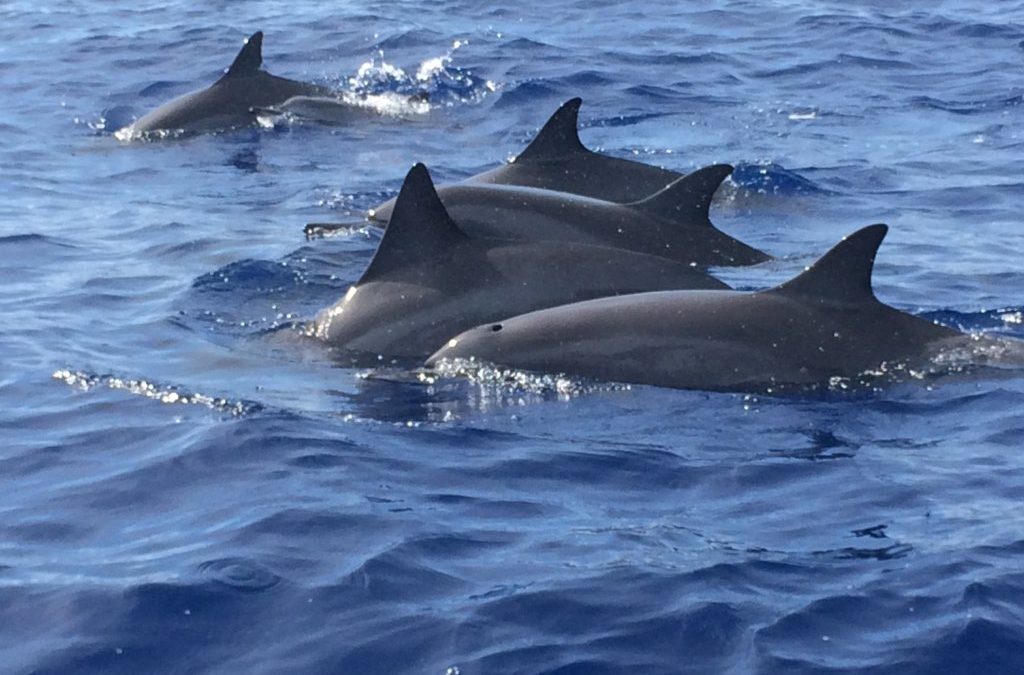Our private Lanai snorkelingtour is a favorite among visitors and locals alike, probably because we specialize small groups and private charters. We take small groups far from the beaten path to experience some of the worlds most pristine reefs and landscapes. As if the mind blowing sights just below the oceans surface weren’t enough, Lana’i is home to at least three different species of dolphin. We are often met by either spotted or spinner dolphins, and we ocassionally encounter the more rare bottle nosed dolphin. We’ve compiled a bit of information about each dolphin species that you are most likely to see so you can brush up before you experience these beauties first hand. All of our trips leave conveniently from Maui’s Maalaea harbor. If you are going to be on Maui between December and May, we also offer whale watches!
Hawaiian spinner dolphins
At dusk Spinner dolphins travel offshore to feed. Spinner dolphins live in an open and loose social organization. The spinner dolphins of Hawaii live in family groups, but also have associations with others beyond their group and mothers and calves form strong social bonds. Vocalizations of spinner dolphins include whistles, which may be used to orangization the structure of the school; burst-pulse signals, which may serve to be evocative and vocative and echolocation clicks. The spinner dolphin has a 10-month gestation period, and mothers nurse their young for one to two years. Spinner dolphins are well known for their acrobatics and aerial behaviors. A spinner dolphin comes out of the water, front first, and twists its body as it ascends in the air. After it reaches its maximum height, the dolphin descends back into the water, landing on its side. A spinner dolphin can make two to 5.5 spins in one leap. These dolphins may also make nose-outs, tail slaps, flips, head slaps, “salmon leaps”, and side and back slaps.
Pan tropical spotted dolphin
Spots are key defining characteristics in adults, though immature individuals are generally uniformly colored and can look like a small bottle nose dolphin. This dolphin has a long, thin beak. The upper and lower jaws are darkly colored, but are separated by thin, white “lips”. The chin, throat, and belly are white to pale grey with a limited number of spots. The flanks are separated into three distinct bands of color — the lightest at the bottom, followed by a thin, grey strip in the middle of the flank, and a dark-grey back. The tall dorsal fin is similarly colored. The thick tail stock matches the color of the middle band. The pan tropical spotted dolphin is very active and is prone to making large, splashy leaps from the sea. Bow-riding and other play with boats is common
Bottlenose dolphins live in groups typically of 10–30 members, called pods, but group size varies from single individuals up to more than 1,000. Their diets consist mainly of fish. Dolphins often work as a team to harvest fish schools, but they also hunt individually. Dolphins search for prey primarily using echolocation, which is similar to sonar. They emit clicking sounds and listen for the return echos to determine the location and shape of nearby items, including potential prey. Bottlenose dolphins also use sound for communication, including squeaks and whistles emitted from the blowhole and sounds emitted through body language, such as leaping from the water and slapping their tails on the water surface. There have been numerous investigations of bottlenose dolphin intelligence. Research on bottlenose dolphins has examined mimicry, use of artificial language, object categorization and self-recognition. Their considerable intelligence has driven interaction with humans. Bottlenose dolphins are popular from aquarium shows and television programs such as Flipper. They have also been trained by militaries to locate sea mines or detect and mark enemy divers. In some areas, they cooperate with local fishermen by driving fish into their nets and eating the fish that escape.


